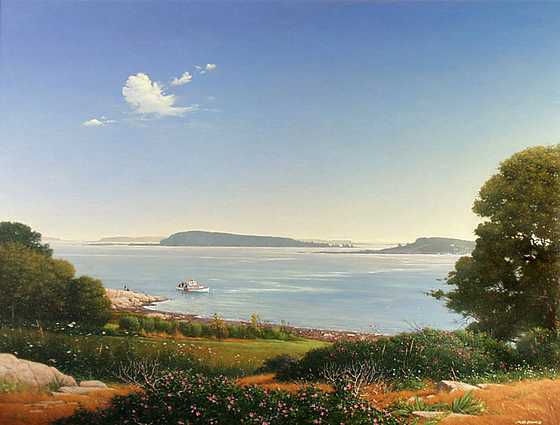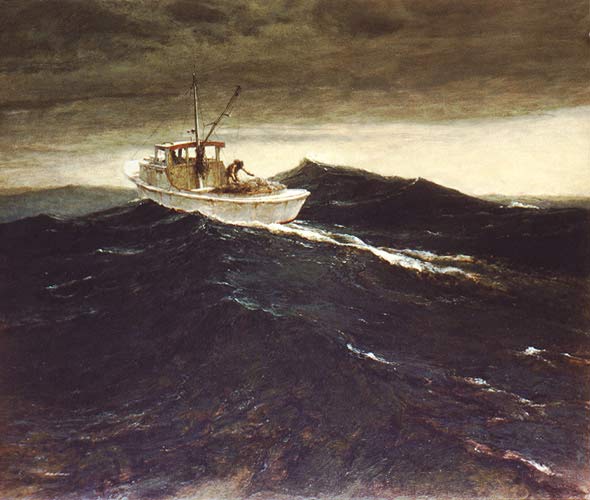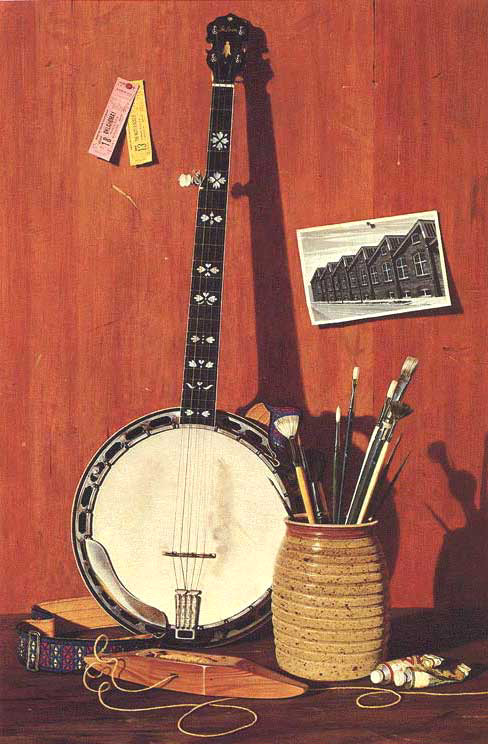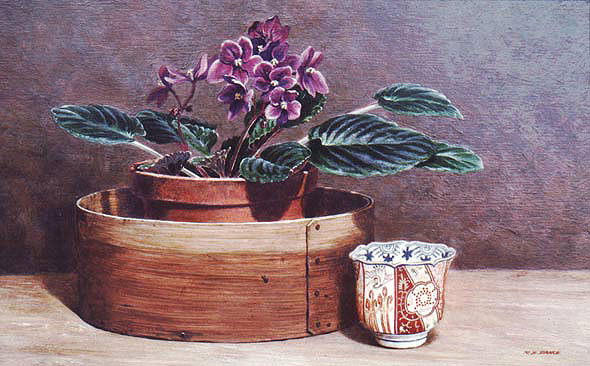| The
invention of Alkyd paints represents a major advance in the development
of artists' materials. Their versatility as a medium allows the artist greater
freedom and a wider range of techniques. Robert B. Dance discusses his approach
to painting in this medium.
Twenty
years ago, when Alkyd paints first made their appearance in this country,
I decided to give the new medium a try because Alkyd seemed to offer several
characteristics I found desirable. Having worked in numerous media, I
have always admired the illusion of depth made possible in the oil medium
by layer upon layer of glaze. This technique, developed by 15th century
Flemish artists such as the van Eycks, introduced the oil medium and a
new dimension to painting. As a painter who has used oils, I found my
particular technique was slowed to a snail's pace in waiting for one glaze
to dry before another could be applied to the painting. Also, I was hesitant
to use driers because of possible harmful effects. I do not wish to imply
that the oil medium is in some manner faulty; such a statement would be
ridiculous. In observing painters, I feel some seem to be more adept in
the slow drying media and others adapt more readily to the faster drying
media. With the advent of Alkyd, it was now possible to glaze in an oil-like
medium which dried overnight and was ready for the next glaze in the morning.
A painter such as myself, who will use 15 to 20 glazes in a sky, will
find Alkyd less time consuming than oil- but the end result very similar.

A View Downeast
Alkyd on masonite panel
22-3/4 x 30 inches
Having related Alkyd to oil, I must say that two of the questions most
frequently asked are: "Is Alkyd similar to oil?" and "Is Alkyd similar
to acrylic?". Oil and acrylic painters should not expect Alkyd to behave
precisely like their old standby medium. To my mind, Alkyd is the major
medium to appear since acrylic, but has quite a different feel, which
separates it from the consistency of acrylic. I would say Alkyd is closer
to oil in feeling and in the end result. After an Alkyd has been varnished,
it would be very difficult to judge it as something other than an oil
painting.
Brilliant
Color
Oil painters, familiar with the buttery consistency
of the oil medium, may find Alkyd color fairly stiff when squeezed from
the tube. I have not found this particular trait of Alkyd to be a problem
since I feel it can be easily dealt with, and can be used to advantage
in drybrush and textural effects. Alkyd can be made buttery through the
use of a thinner such as rectified petroleum and the addition of Liquin
as a medium. I will describe how I prepare Alkyd on the later in this
article.
The colors offered in the Alkyd line rank among the
finest I have used in any medium. This is due to greater pigment density
which results in very strong and brilliant color. I find it excellent
in tinting strength. Because Alkyd resin is used instead of a linseed
oil base as in traditional oil color, the colors are less yellowing and
have greater resistance to cracking. The thirty colors offered should
be more than enough to please most painters. Should you feel the need
for a color not offered, oil can be used on these rare occasions.
Since oil color can be used with Alkyd, I should mention
that the addition of a linseed oil based pigment or the use of a slow
drying oil (linseed oil, stand oil) medium will slow the drying time of
Alkyd. They are compatible, but the drying will be slower. This effect
should be remembered if you desire to extend the drying time of Alkyd.
Normally Liquin should be used as a medium for Alkyd since it is based
on synthetic resin which dries at the same rate. Alkyd can also be thinned
with turpentine, but rectified petroleum is recommended. Due to the technique
I use with Alkyds, I have not had the occasion to slow the drying time.
I prefer to take advantage of the rapid drying time and use Liquin as
a medium, rectified petroleum as a thinner and no additional colors from
oil colors. I do feel however, that oil painters might find the use of
Alkyd a rapid way to develop their underpainting- to be finished in their
normal manner with oil color. Do not try to mix Alkyd with any medium
other than oil.
New Techniques
Some painters who are comfortable with a familiar
medium may be hesitant to try a newly introduced medium. Indeed, there
are many artists who specialize in a particular medium and never divert
from it, building a successful career through the mastery of a single
medium. While this is perfectly acceptable, I wonder if their work might
have benefited by the attempt at something new, or if a new approach might
have opened new doors. In trying a new approach, new techniques are often
learned that can be applied to old, familiar media. The anticipation and
newness of trying something different may in itself obviate the sameness
which may dull a painter's work. I feel certain that Degas' work in oil,
sculpture and drawing had a beneficial effect on his pastel work and vice
versa. Of course there are supreme artists, such as Vermeer, who have
left us work in one medium- but I feel it is probable that such a master
produced work in other media that has been destroyed or sadly lost. How
wonderful it would have been to see a Vermeer drawing or watercolor.
The technique in handling Alkyds is not exotic by any
means and should not be shied away from for that reason. Alkyds, like
other paints, consist of pigment, binders, painting mediums and thinners.
Binders may consist of gum arabic for watercolor, egg yolk for tempera,
acrylic emulsion for acrylic, and linseed oil for most oil colors. The
binder for Alkyd colors is an Alkyd resin which does not contain free
oil and is resistant to deterioration. The process of working with Alkyd
is very similar to the process of working with oil colors in that you
use mediums and thinners that are much the same, and often compatible.
Therefore, Alkyds should not present insurmountable problems for painters
who have experienced other media.
Should you decide to give it a try and not wish to
purchase a large set, there is a small starter set of 12 colors available.
The tubes are rather small, but are probably sufficient to give you the
feel of the medium for a small painting. The range of colors is also adequate,
but I personally would add raw umber, raw sienna and burnt sienna. You
should also purchase Liquin medium and a thinner such as rectified petroleum
or turpentine.
Next, I will describe the procedure I use in painting
with Alkyds. Most painters will fall into their own technique with any
given medium and feel comfortable with that technique after a time. I
don't believe there are any "tricks" in painting, but perhaps my procedure
may help others avoid a few of my own past pitfalls.

Return to Beaufort
Alkyd on masonite panel.
Here multiple glazes of Alkyd have been applied,
particularly in the rendering of the sea.
Procedures
and Techniques
I will now describe the general procedure I use in working with
Alkyds. As I previously stated, I do not think there are any tricks in
painting and everyone will settle into his or her own technique as they
progress in any given medium. I have always felt that painting is an extremely
personal process of decision-making which is very hard work. The result
of your efforts, good or bad, is predicated by your knowledge, what you
are trying to say, discipline and the decisions you have made within the
framework of what you are trying to do. I have not met many good painters
who are smugly satisfied with their work, and I have never met an ëartistí.
To my mind, that term belongs to those few you can count on the fingers
of one hand during any given period of history... Leonardo, van Eyck,
Durer, Vermeer, Degas. Most of us are painters striving towards that very
elusive end and the pursuit of that goal should enhance our efforts.
Let me begin with the surface on which the paint will be applied.
I have used both primed linen canvas and gessoed masonite panel. Most
of my panting is done on masonite which has been sanded and gessoed with
at least three coats of acrylic gesso on the painting surface and two
coats on the back. The gesso on the back and edges will seal the panel
and keep the board from warping too badly. I apply gesso with a one and
a half inch bristle brush of the type used for varnishing wood (such as
a sailboat mast). The first coat is applied on the horizontal, the second
at 45 degrees right, the third at 45 degrees left. I do not sandpaper
this surface to a great extent.
A word here about masonite hardboard: you should use the ëuntemperedí
type that is not oil impregnated. The type you do not want is ëtemperedí
or exterior grade, which is usually darker in color. The reason you do
not want this type is because the impregnated oil may bleed through the
painting and discolor it. In the USA, untempered masonite has a green
marking painted on one of its edges. The tempered masonite has a red edge
marking. ìGreení- go ahead; ëredí- stop and
forget it. Lately, however, there seem to be many versions of hardboard
sold by lumberyards in this country which they call masonite. Stay away
from the pulpy or loosely-pressed type, even if it has the green marking.
You want a fairly hard board in which the filaments are tightly pressed.

Winston Square
Alkyd on masonite panel
Drying
Rate
Since Alkyds will dry overnight on the palette, I use a disposable
paper palette. Also, I feel I can mix colors more accurately on the white
surface of a paper palette. To this palette I clip the traditional double
tin medium cups. Pour a small amount of rectified petroleum into one cup
and a small amount of Liquin into the other cup. The drying rate of Liquin
is about the same as Alkyd and, unless you plan to use a great amount,
this small measure is usually adequate.
The colors on my palette usually consist of: alizarin crimson, cadmium
red, raw umber, burnt sienna, raw sienna, yellow ochre, cadmium yellow,
sap green, cerulean blue, cobalt blue, French ultramarine and titanium
white. This is but a small portion of the full range of colors offered
in Alkyd, and I will sometimes use other colors if I feel the need for
them. I do not use black because I do not find absolute black in nature.
My darks are mixed from blues and earth colors.
Because of the rapid drying rate of Alkyd, it is best not to apply
more pigment to the palette than you can use in a day of painting. Any
excess will dry overnight and be wasted. I squeeze colors onto the palette
in 3/4 inch to one inch doughnut-shaped circles. Next, using a glass eyedropper,
I dispense three drops of rectified petroleum into the center of each
circle of color. A small palette knife is then used to work the rectified
petroleum into the color, This will give the medium a buttery consistency
and slow the drying rate on the palette. Should you desire certain effects
such as drybrush and texture, you may want to use the color without the
addition of rectified petroleum.
The Liquin is an excellent medium especially recommended for Alkyd
since it dries at the same rate. I find it excellent for thin glazes,
and I feel glazing is one of Alkydís strong points. Should you
wish to slow the drying rate, use an oil color medium based on a slow
drying oil.
The brushes I use are the usual oil selection of bristles and long-handled
red sable brushes. Next to my easel is a brush-washing can with a spring
type brush holder at the top. This is filled with turpentine, which is
a bit less expensive than rectified petroleum as a brush cleaner.

African Violets
Alkyd on masonite panel
Texture
As a realist, I usually know exactly what I am aiming for in the
way of composition, drawing and atmosphere. Most of these problems are
worked out in small pencil sketches and studies. I then draw the composition
lightly with a 2H pencil on the panel or canvas. This drawing is not in
great detail and consists for the most part of the outline of masses.
From this point the Alkyd painting goes much like the oil painting: a
thin underpainting followed by a gradual build-up of paint to arrive at
a feeling of texture and depth.
I try to keep the hardest edges restricted to the foreground and
center of interest. In nature, as you focus on the foreground, the objects
become hazy and the edges melt into their surroundings. However, the foreground
edges should not all be hard, or the object will appear to be cut out
and flat as in a collage. These nebulous edges can be blended before the
Alkyd dries, or glazed over with translucent glazes to achieve the hazed
effect.
I will often use 15 to 20 glazes in my skies and water to achieve
a feeling of depth. Light penetrates these glazes and is bounced back
by the under-painting or opaque surface below giving the illusion of depth.
Vibrant color can also be achieved in glazes by applying one color over
another, such as a red glaze over a yellow, which results in a glowing
red that would be difficult to arrive at with opaques. My glazes are applied
by brush, rubbed on with my hands or by palette knife, depending on the
effect I wish to achieve. Alkyd is perfect for these glazes because of
the drying time- 20 glazes in oil would take a considerable time in drying
and waiting to apply the next glaze. You should, however, let an Alkyd
glaze dry completely before putting the next glaze over it. Unless you
wait, there seems to be enough soluble material in the glaze to lift the
glaze below it. Usually, I let a glaze dry overnight before applying another.
The use of Alkyd should not dictate a drastic change in your technique
of painting thick or thin. Oleopasto is available for heavy impasto effects.
Should you want to blend Alkyd, you should do so within a given day, as
the surface will be dry the following day. Therefore, it calls for a direct
positive approach when blending. My own paintings do not have a heavy
build-up of paint, but I do like to see evidence of the brushstroke and
some texture.
Due to my realistic subject matter, multiple glazes and concern
for texture, it often takes me from a month to three months to finish
a painting. When you have decided the painting is finished, set it aside
to dry thoroughly before varnishing. Quite by accident, I noticed Alkyd
seems to dry faster when there is a fan in the studio. Depending on how
thickly you paint, the painting can be varnished in about 30 days. I use
spray damar varnish. First, I spray on a coat of regular gloss damar and
follow it with a light coat of matt damar while the first coat is still
wet. This achieves a slightly matt finish which I prefer.
As I stated previously, I believe Alkyd is the major medium to be
introduced since acrylic paints. All the various media I have used have
their strong points and all should be approached on their own level. Each
is demanding in its own way... if you are an egg tempera painter or a
watercolorist you should know what I mean. Painting a picture is a difficult
endeavor in any medium. I am sure I never mastered crayons, and pastel
left me in clouds of dust. Trying a new medium is an interesting and refreshing
experience that does not come along too often- there were roughly 25 years
between the introduction of acrylic and Alkyd in the USA. Personally,
I am very happy I gave it a try.
This article
originally appeared in The Artist magazine.

|


